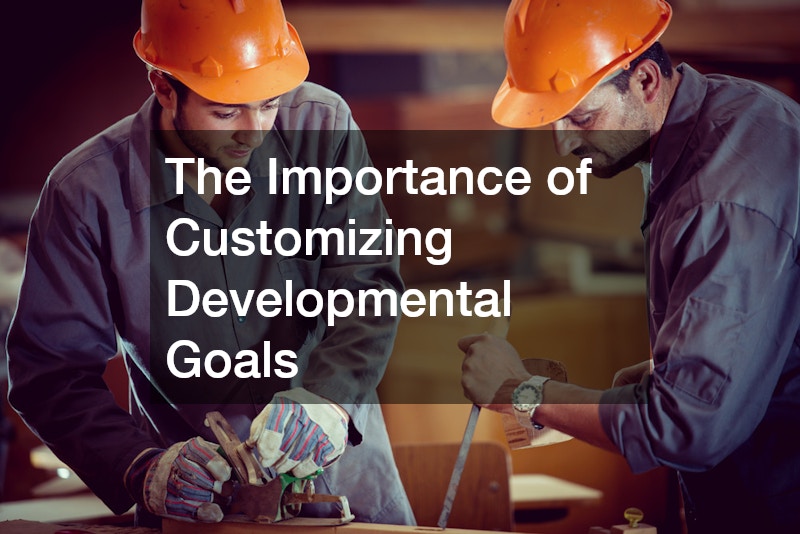
In today’s fast-paced world, the notion of developmental goals for employees is more critical than ever. With industries ranging from roofing companies to dental offices facing constant change, the need for continuous education is paramount. Not only does this ongoing learning contribute to personal and professional growth, but it also enhances overall workplace effectiveness. By understanding the significance of developmental goals, we can appreciate how they foster a culture of growth and innovation across various fields, from masonry service to mechanical insulation services.
1. What Are Developmental Goals for Employees?
1.1 Definition and Importance
Developmental goals are specific objectives that employees aim to achieve in their professional journey. These goals often focus on enhancing skills, acquiring new knowledge, and contributing to both individual and organizational success. In sectors such as emergency dive service and crane service, where technical skills are essential, having clear developmental goals ensures that employees are well-prepared to meet the demands of their roles.
1.2 Types of Developmental Goals
Developmental goals can be classified into various categories. Short-term goals may involve mastering a specific task, while long-term goals might include leadership aspirations or achieving advanced certifications. For instance, an industrial electrician might set a goal to become proficient in the latest electrical codes or safety standards, aligning their aspirations with the evolving needs of the industry.
1.3 Aligning Goals with Company Objectives
Effective developmental goals align with the overarching objectives of the organization. This alignment ensures that employees’ growth contributes directly to the company’s success. In roofing companies, for instance, having employees skilled in fall arrest systems can improve safety and efficiency, benefiting both the workforce and the organization as a whole.
2. How Does Continued Education Impact Employee Satisfaction?
2.1 Enhancing Skills and Knowledge
Continued education empowers employees by enhancing their skills and knowledge. This is particularly vital in technical fields such as mechanical insulation services, where keeping up with industry standards and innovations is crucial. Employees who engage in continuous learning feel more competent and equipped to tackle challenges in their roles.
2.2 Boosting Confidence in the Workplace
As people enhance their skills through developmental goals for employees, their confidence in the workplace also grows. For example, local lawyers who participate in ongoing legal education can navigate complex cases with greater assurance, leading to improved outcomes for their clients. This boost in confidence translates to better job performance and a more positive work environment.
2.3 Retention Rates and Job Satisfaction
Organizations that prioritize continued education often experience higher retention rates. When employees see that their company is invested in their growth—whether through workshops, formal education, or on-the-job training—they are more likely to remain committed. This is particularly important in competitive fields like dental offices, where retaining skilled staff can significantly impact patient care and service quality.

3. What Are Some Effective Educational Strategies for Professional Growth?
3.1 Formal Education Programs
Formal education programs, such as degree or certification courses, provide structured learning opportunities. Employees in various industries, from roofing companies to masonry services, can benefit from these programs by acquiring formal qualifications that enhance their employability.
3.2 On-the-Job Training
On-the-job training is another effective strategy for professional growth. This hands-on approach allows employees to learn in real-time, applying new skills directly to their roles. For instance, a crane service operator might undergo training on new machinery while working alongside experienced colleagues, ensuring immediate and relevant skill application.
3.3 Workshops and Conferences
Workshops and conferences offer opportunities for networking and knowledge sharing. Employees can learn about the latest trends and technologies in their field, whether that’s through specialized masonry service workshops or industry conferences for emergency dive service professionals. These interactions often lead to innovative ideas and improved practices within the organization.
4. How Can Employees Set and Achieve Their Developmental Goals?
4.1 Identifying Personal Strengths and Weaknesses
To set effective developmental goals, employees must first identify their personal strengths and weaknesses. Self-assessment can guide employees in determining areas for improvement. For example, an industrial electrician might recognize a need to enhance their understanding of emerging technologies in electrical systems.
4.2 SMART Goals Framework
The SMART goals framework—Specific, Measurable, Achievable, Relevant, and Time-bound—provides a clear structure for goal setting. Employees should aim to create goals that fit this framework to increase the likelihood of success. For instance, a local lawyer might set a goal to complete a specific number of continuing legal education credits by the end of the year, making it easier to track progress.
4.3 Regular Progress Evaluation
Regularly evaluating progress toward developmental goals is crucial for staying on track. Employees can schedule periodic check-ins with supervisors or mentors to assess their advancement and make necessary adjustments. This reflective practice is beneficial in industries like mechanical insulation services, where skills can quickly become outdated.
5. Why Is Management Involvement Crucial in Employee Development?
5.1 Supportive Leadership
Supportive leadership plays a vital role in fostering employee development. Managers who encourage their teams to pursue continued education demonstrate a commitment to their growth. This support is especially important in industries such as crane service, where safety and expertise are paramount.
5.2 Providing Resources and Opportunities
Management must provide the necessary resources and opportunities for employees to pursue their developmental goals. This might include funding for educational programs, access to workshops, or time off for study. For example, roofing companies that invest in safety training for fall arrest systems not only protect their employees but also enhance overall workplace safety.
5.3 Building a Culture of Learning
Creating a culture of learning within an organization encourages employees to pursue ongoing education. When companies prioritize professional development, employees feel more motivated to engage in learning opportunities. In fields like dental offices, where staying updated on the latest practices is crucial, this culture can lead to improved patient care.

6. What Role Do Technological Advancements Play in Continuing Education?
6.1 Accessible Online Learning Platforms
Technological advancements have made continuing education more accessible than ever. Online learning platforms allow employees in various industries to participate in courses and training programs from anywhere. This flexibility is particularly beneficial for busy professionals in sectors like emergency dive service or mechanical insulation services.
6.2 Integrating Tech into Traditional Learning
Integrating technology into traditional learning methods can enhance the educational experience. For instance, using telephone systems software for communication during training sessions can facilitate collaboration among participants, regardless of their physical location.
6.3 Emerging Technologies and Skill Requirements
As industries evolve, so too do the skills required to succeed. Organizations must stay ahead of emerging technologies by offering training that reflects these changes. For example, industrial electricians might need training on the latest automation technologies to remain competitive in the job market.
7. How Does Continuous Education Affect Career Advancement?
7.1 Qualifications for Promotion
Continuous education often serves as a pathway to promotion. Employees who actively pursue professional development are more likely to qualify for higher positions within their organizations. In roofing companies, employees who undergo training in advanced safety protocols may be considered for supervisory roles.
7.2 Building a Competitive Edge
In today’s competitive job market, having a strong educational background can provide a significant advantage. Employees who engage in continued education stand out to employers, making them more desirable candidates for promotions and new opportunities. For example, local lawyers who continually update their legal knowledge can better serve their clients, thereby advancing their careers.
7.3 Networking and New Opportunities
Continued education often opens doors to networking opportunities that can lead to career advancements. By attending industry conferences or workshops, employees in fields like crane service or masonry service can connect with professionals who may offer mentorship or job opportunities.
8. What Challenges Do Employees Face in Pursuing Continued Education?
8.1 Time Management and Work-Life Balance
Balancing work responsibilities with continued education can be challenging. Employees often struggle to find time for learning amid their daily tasks. Effective time management strategies, such as prioritizing tasks and setting aside dedicated study time, can help mitigate these challenges.
8.2 Financial Constraints
Financial constraints can also be a barrier to continued education. Many employees may find it difficult to afford tuition or training costs. Organizations can alleviate this burden by offering tuition reimbursement programs or financial support for educational initiatives, particularly in high-demand sectors like a dental office or emergency dive service.
8.3 Overcoming Skill Gaps
Employees may also face skill gaps that hinder their ability to pursue further education. Identifying these gaps early and addressing them through targeted training programs can help employees build a foundation for advanced learning.

9. How Can Companies Measure the Impact of Developmental Goals?
9.1 Key Performance Indicators (KPIs)
Companies can measure the impact of developmental goals by establishing Key Performance Indicators (KPIs). These metrics can help assess the effectiveness of educational initiatives and track employee progress. For example, a roofing company might monitor safety incident rates before and after implementing a new training program on fall arrest systems.
9.2 Feedback Systems
Implementing feedback systems allows employees to provide input on their educational experiences. This feedback can guide future training initiatives and help organizations refine their approach to employee development.
9.3 Long-Term Impact Analysis
Long-term impact analysis helps organizations understand how developmental goals influence employee performance over time. By tracking promotions, retention rates, and overall job satisfaction, companies can gauge the effectiveness of their educational investments.
10. What Future Trends Are Expected in Employee Development and Education?
10.1 Personalized Learning Pathways
The future of employee development is likely to involve more personalized learning pathways tailored to individual needs and career aspirations. This approach allows employees to pursue educational opportunities that align with their specific goals, whether they work in masonry service or as industrial electricians.
10.2 Lifelong Learning Culture
Organizations are expected to foster a culture of lifelong learning, encouraging employees to view education as an ongoing journey rather than a one-time event. This shift in mindset can lead to more engaged and skilled workforces across various industries.
10.3 Integration of AI and Machine Learning
The integration of artificial intelligence and machine learning into educational programs will likely transform how employees learn. These technologies can personalize learning experiences, recommend resources, and even assess progress in real-time, making education more efficient and effective.
11. How Do Developmental Goals Enhance Team Dynamics?
11.1 Fostering Collaboration and Communication
Developmental goals can significantly enhance team dynamics by fostering collaboration and communication among team members. When employees engage in continuous education, they often participate in group learning environments such as workshops or training sessions. This interaction encourages knowledge sharing, where employees from different backgrounds—such as those from roofing companies and local lawyers—can exchange insights and best practices. Improved communication leads to stronger relationships, enhancing overall team cohesion.
11.2 Building a Supportive Environment
When organizations emphasize developmental goals, they cultivate a supportive environment that encourages teamwork. For example, a masonry service team might work together to tackle new techniques learned in a training session, reinforcing their skills and building trust among colleagues. This collaborative spirit not only enhances individual growth but also contributes to collective success, creating a workforce that is more engaged and motivated.

12. The Importance of Customizing Developmental Goals
12.1 Addressing Individual Learning Styles
Each employee has unique learning preferences and styles, making it essential for companies to customize developmental goals to fit these diverse needs. For instance, some individuals may thrive in hands-on training, such as the on-the-job learning seen in crane service, while others might prefer formal coursework or online modules. By recognizing and accommodating different learning styles, organizations can create more effective educational programs that resonate with all employees.
12.2 Aligning with Personal Aspirations
Customizing developmental goals also involves aligning them with employees’ personal aspirations and career objectives. For example, an industrial electrician may aspire to become a project manager. By offering tailored training opportunities—such as leadership courses or project management certifications—companies can support their employees in reaching these goals. This alignment not only benefits the individual but also enhances the organization’s talent pool, ensuring that employees are prepared for future leadership roles.
Conclusion
In summary, developmental goals for employees are vital in fostering a culture of continuous education across all industries. By enhancing skills, boosting confidence, and contributing to job satisfaction, ongoing learning plays a crucial role in personal and professional growth. Organizations that prioritize employee development not only empower their workforce but also position themselves for success in an ever-evolving market. Whether in roofing companies, emergency dive service, or dental offices, the significance of developmental goals remains clear: they are the key to unlocking potential and driving advancement in today’s competitive landscape.




